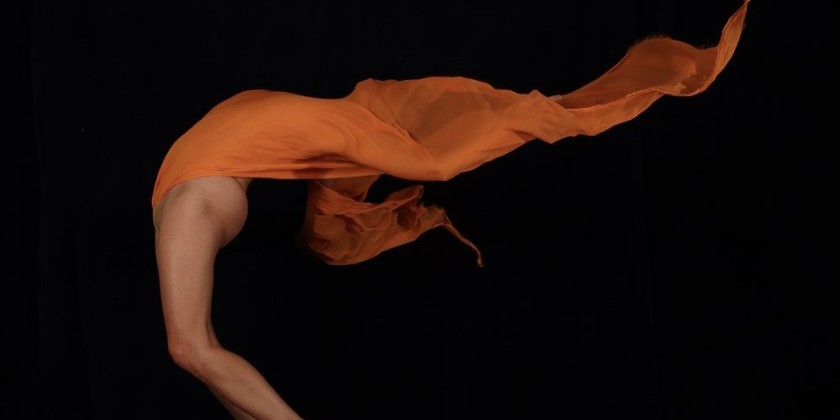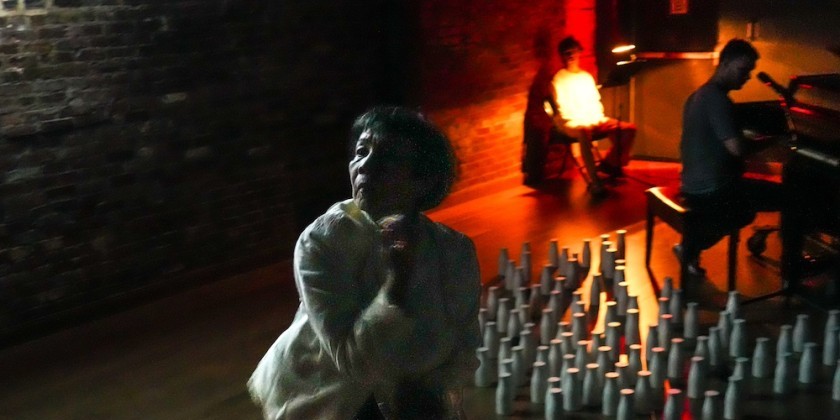IMPRESSIONS: "LAZARUS 1972-2022" Ping Chong and Company at La MaMa Conceived, written, and directed by Ping Chong

Cast: Christopher Caines…Lazarus / Jeannie Hutchins…Woman / Chaesong Kim…Figure 1
Nancy McArthur…Figure 2 / Tiffany Tan…Figure 3 / Voiceover Performers: Louise Smith and Ping Chong
Voiceover text by Linda Nguyen and Ping Chong
Production Team: Hao Bai, Lighting Designer / Katherine Freer, Projection Designer/ Nitsan Scharf, Projections Associate
Stefani Mar, Costume Designer/ Watoku Ueno, Set Designer/ Ernesto Valenzuela, Sound Designer
Courtney Golden, Production Associate/ Sarah Murphy, Production Manager/Bruce Allardice, Executive Director/ Jane Jung, Managing Director /Sarah Zatz, Associate Director
The food isn’t bad here, if only a man could eat his lunch in peace. Alas! The title character of Ping Chong’s Lazarus 1972-2022 never gets to finish his meal. A frustrating interruption all too typical of life has followed Lazarus into the tomb, in this legendary multi-media work that Ping Chong and Company revived, on Sunday, at LaMaMa’s Downstairs Theatre.

Lazarus has just taken a satisfying swig of coffee, and has licked the last thrilling bit of mustard from his knife. Before he can bite into his sandwich, however, one of the kuroko-like stagehands who has crept in behind him whips around and presents him with what appears to be the check. Lazarus is lucky that it isn’t a bill, after all. For, God knows, the price of a sandwich today is not what it was in the good old days, when Chong first presented a low-budget, 20-minute version of this poetic dreamscape in Meredith Monk’s loft, back in 1972.
Instead, the stagehand offers Lazarus a letter from his niece, Leila, who is unaware that he has died and is now wearing funeral cerements wrapped around his head. She hopes he’s feeling better. Leila also wishes to inform her uncle that “Andrew’s” alcoholism, and her family’s dysfunction have proven more than she can manage; and she’s striking out on a journey that she hopes will bring redemption to all.

LAZARUS 1972-2022 Ping Chong and Company at La MaMa; Photo: Richard Termine
After this disturbing news, Lazarus, played with deft understatement by Christopher Caines, gives no more thought to lunch. He begins to stalk Jeannie Hutchins, a woman in a red dress who may be Leila, or the memory of another woman Lazarus has known. She appears on and off, sometimes carrying an illuminated water glass, like a radioactive cocktail, or kneeling on the floor studying a portrait and tracing the outlines of the face with her finger.

All these comings and goings, not to mention the chores of the three stagehands, whom Chong keeps busy setting the lunch table, strewing autumn leaves, etc., take place in a small room behind a sliding screen, which, like the 300-sq.-foot apartment Chong inhabited at the age of 26, is overflowing with ideas.

From the grate-shaped pattern of light that appears on the floor, we understand this space is subterranean: the classic existential locus found in Dostoevsky’s Notes from Underground and in Ellison’s Invisible Man. The room is not merely a tomb, therefore, or a way-station like Purgatory, but a refuge from chaotic violence and scientific determinism. At one point Lazarus stands beneath the ceiling grate and listens attentively as the sounds of a political demonstration filter down from the street. Often the flutter of feathers and the beating of wings can be heard coming from no place in particular. Like the ravens glimpsed in an introductory film, these sounds are ominous reminders of disaster.
Curiously, perhaps, for a show that has been tweaked to contrast a bygone world with the here-and-now, Lazarus 1972-2022 avoids mentioning the disasters that have bludgeoned and scarred New York City in the intervening decades. We see filmed street scenes, the black-and-white footage gradually colorizing as we approach the present. Chong shies away from depicting the Vietnam War, however, or the AIDS epidemic. The fall of the Twin Towers, the Iraq War, and the ongoing Covid scamdemic remain outside his frame. Instead, he shows us a campy allegory of destruction: scenes from the sci-fi fantasy 20 Million Miles to Earth, in which a giant lizard menaces Rome.

Maybe civilization really is threatened. Viewers will have to do their own thinking, however, to pinpoint the identity of the monster. Should we fear “Otherness,” or is the real threat hiding close to home?
In any case, Chong is finished. After 50 years of stunning creativity, the current season marks his last as director of the company he founded. When, at the end of Lazarus 1972-2022 the resurrected hero goes flying off in puppet form, it’s Chong who feels the thrill of release. If only the poor puppet weren’t required to wear a surgical mask.
Following Sunday’s performance, Chong and some of his cronies gathered in an informal panel to reminisce. Yes, the 1970s were halcyon days in which cheap rents and a culture of resource-sharing encouraged artistic experiment. Yes, in comparison the current theater scene is a nightmare of bureaucracy, impossible prices, and political correctness. Yet even in the 1970s, a bias against the spoken word suggested profound uneasiness with freedom. What were they afraid to say, then? And what are we afraid to question, now? Where is the avant-garde, when you really need it?













